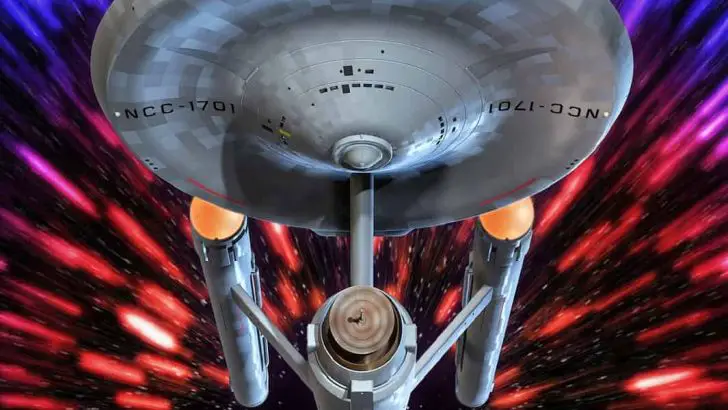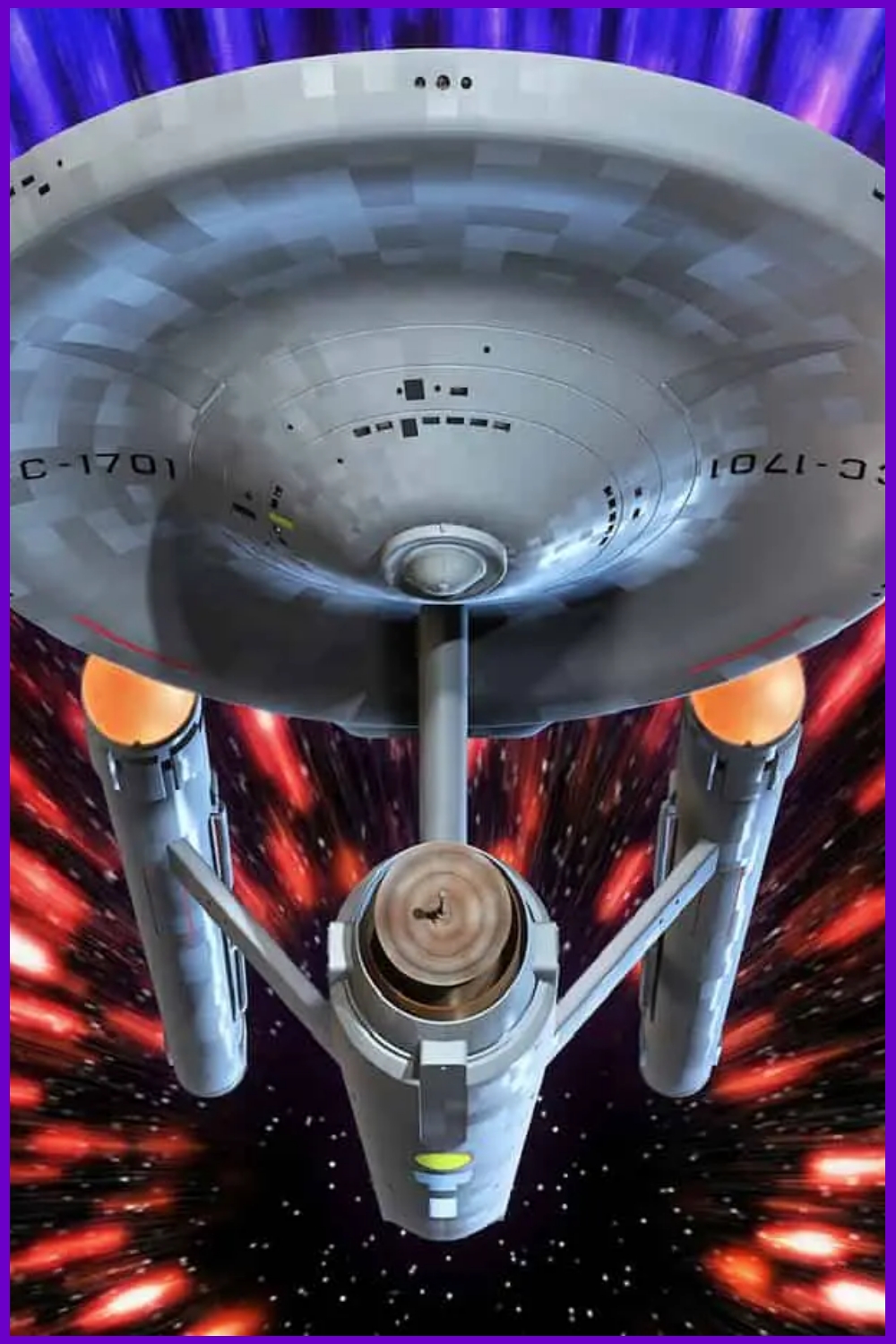Fans of Star Trek know that the universe of the franchise is huge. It spans light-years in all directions away from the Earth. So, how big is the Star Trek universe anyway?
The Star Trek universe is infinite. The franchise is centered primarily in the Milky Way galaxy, and only around 19 to 20% of it has been explored. Even though humans have limited knowledge of the universe, there are advanced species within the Federation that know much more.
Let’s take a closer look at how big the Milky Way is and how we know the size of the Star Trek universe.
The Star Trek Universe
Before we dive into the Star Trek franchise, we’re going to take a look at the size of the Milky Way. It’s important to know in order to understand the scale of the Star Trek universe.
The Milky Way is roughly 200,000 light-years across. There were previous studies that suggested 100,000 light-years, but that’s no longer correct. You can see a map of Star Trek’s Milky Way by clicking on the link. This is based on the old knowledge that the galaxy is 100,000 light-years across.
In Star Trek: The Next Generation, Wesley Crusher mentioned in episode 10 “The Dauphine” of season two that only 19% of the galaxy has been explored. However, we know that the universe is bigger than that.
While only 19% of the Milky Way has been explored, we know that the USS Enterprise has journeyed outside of the galaxy. It’s also the only starship to have made that journey and returned. In episode six of season one, “Where No One Has Gone Before,” a traveler sends the Enterprise to what is referred to in the episode as the end of the universe.
This is the only time in the franchise that a human crew has gone there. But this episode expanded the Star Trek universe considerably. Also, in this episode, after exceeding warp ten and finding themselves in an unknown region, Lieutenant La Forge tells Captain Picard that they have traveled outside the Milky Way and past two other galaxies.
They find themselves in a galaxy known to the Federation as M-33. They had to cross 2,700,000 light-years to reach it. With their technology at the time of this episode, at maximum warp, it would take them 300 years to return to their own galaxy. This information was listed in the Federation’s computer database.
How Do We Know the Size of the Universe?
In the episode “Where No One Has Gone Before” from The Next Generation, the Enterprise attempts to return home and is instead hurtled forward even further. The crew finds itself one billion light-years away from the Milky Way. Throughout the episode, this area of the universe is referred to as the end of the universe.
So, while we don’t know the true size of the universe in light-years, we do know it stretches at least one billion light-years away from our own galaxy. However, we don’t know how far beyond that.
The Four Quadrants of the Milky Way
While the universe is infinite, the Star Trek franchise takes place almost entirely in the Milky Way galaxy. It’s separated into four quadrants, and humanity has only traveled a small amount of each quadrant.
Alpha
The majority of the franchise (except for Deep Space Nine and Voyager) takes place within the Alpha quadrant. Earth is located here as well as a large portion of the United Federation of Planets.
Because Earth is here, the majority of the travel done by the starships in the shows and movies is done within this quadrant. However, that doesn’t limit the Star Trek universe to this area of the galaxy. This just happens to be the most well-known region.
In this quadrant, you’ll find the worlds of Tellar, Trill, and Betazed in addition to our own solar system. There are some who believe parts of the Klingon and Romulan empires reside in the Alpha quadrant. However, the majority of these empires remain in the Beta quadrant.
Beta
Just like with Alpha, the Beta quadrant holds the remainder of the Federation. This means that also like Alpha, many of the shows and movies take place in this region of the galaxy.
In this region, most of the Klingon and Romulan empires are located here. Beta also contains Vulcan, Andoria, Risa, and Rigel. There are some resources out there that believe the Klingon and Romulan empires are located completely within the Beta quadrant and don’t cross into Alpha at all.
Gamma
The Gamma quadrant was only explored remotely until a wormhole was discovered close to the Bajor region in the Alpha quadrant. It allowed people from Alpha to travel to Gamma without wasting years and years in travel time.
This wormhole, known as the Bajoran wormhole, brought the Federation in contact with the Dominion. This is the enemy we face in the TV show Deep Space Nine. They also control the wormhole.
Delta
The Delta quadrant remains mostly unexplored. When the USS Voyager ended up stranded in this region, they spent years traveling back to Earth. They made a straight line back to the Alpha and Beta quadrants.
In this area of the Milky Way, it was known before their arrival into the Delta quadrant that this was the home of the Borg. However, on their way back to Earth, Voyager discovered it was also home to the Kazon sects, the Vidiians, the Hirogen, and Species 8472.
The Size of the United Federation of Planets
What the characters (and the fans) know about the universe is recorded in the Federation’s database. This is limited knowledge of the universe, as we learn throughout the journeys of each adaptation of the franchise.
The actual size of the Federation spans across 8,000 light-years of space and reaches into both sides of the Alpha and Beta quadrants.
For a fan-made map of the Federation and most of the known Star Trek universe, you can click on this link here. It shows the size of the Federation and where Klingon and Romulus are located as well as several other worlds that have been explored.
That map follows the belief that the Klingons and Romulans are located entirely in the Beta quadrant, rather than on both sides of the median.
Star Trek: Discovery and the Galaxy of the Future
Throughout all of the shows, there are many instances where an alien character tells the human crew that there is more out there—that we lack the intelligence to understand this greater expanse. Or that we’ll find ourselves in those regions once we reach that needed level of intellect.
With the upcoming release of season 3 of Star Trek: Discovery, we may get the chance to explore those new worlds and regions with the crew. The humans have jumped over 900 years into the future, and according to an interview with the franchise’s boss, Alex Kurtzman, he states that the show will explore areas of the universe that haven’t been explored before.
Summary
It isn’t easy to pinpoint the exact size of the Star Trek universe truly. The humans of the franchise have only explored a small percentage. However, they have met with species of aliens who have traveled all across the universe, expanding it for them. Hopefully, this article has given some insight into how big the Star Trek universe is and how we know what we know.
Sources
- Star Trek Map: Stellar Cartography – 22nd Century
- Wikipedia: Star Trek
- Wikipedia: Timeline of Star Trek
- Over Mental: The Definitive Chronological Viewing Order For The Star Trek Cinematic Universe
- Space: Star Trek: History & Effect on Space Technology
- Hollywood Reporter: How ‘Picard’ Reshapes the ‘Star Trek’ Galaxy
- Continuing Mission: HISTORY OF THE FEDERATION PART II
- Star Trek Dimension: The Route of the USS Voyager
- Digital Spy: How Star Trek Discovery fits into the Original Series’ timeline
- Games Radar: Star Trek timeline: Boldly go on a chronological journey through the Trek universe
- Wikipedia: Milky Way
- Live Science: How Long Would It Take to Cross the Milky Way at Light Speed?
- Star Trek: Alpha Quadrant
- Star Trek: Delta Quadrant
- Wikipedia: List of Star Trek regions of space
- Fandom: Universe
- Stack Exchange: How big is the known Star Trek universe?
- Trek Core: Alex Kurtzman on STAR TREK: DISCOVERY’s New Future
- Star Trek Dimension: The journey of Voyager
- Star Trek Dimension: The mission of Enterprise NX-01
- Star Trek Dimension: Atlas
- Trek BBS: How far has Starfleet explored
- Vulture: A Beginner’s Guide to the Star Trek Universe
- Reddit: Fan-Made Map
- Star Trek Dimension: Star Trek Cartography
- Star Trek Dimension: The division of the Star Trek Galaxy
- Brilliant Maps: Star Trek Map Of The Alpha & Beta Quadrants
- The Verge: New Star Trek series based on the USS Enterprise is heading to CBS All Access
- Reddit: How much of the galaxy had been explored by Starfleet in the 31st century?
- Syfy: EVERYTHING YOU DIDN’T KNOW ABOUT STAR TREK: VOYAGER
- Quora: Why is there no intergalactic travel in Star Trek?
- Fandom: Federation star charts
- Fandom: 31st century
- Star Trek: United Federation of Planets
- Wikipedia: Geordi La Forge
- Wikipedia: Jean-Luc Picard
- Wikipedia: Star Trek: The Next Generation
- Wikipedia: Wesley Crusher
- Wikipedia: USS Voyager (Star Trek)
- Wikipedia: Romulan
- Star Trek: Gamma Quadrant
- Wikipedia: Dominion (Star Trek)





Leave a comment
You must be logged in to post a comment.